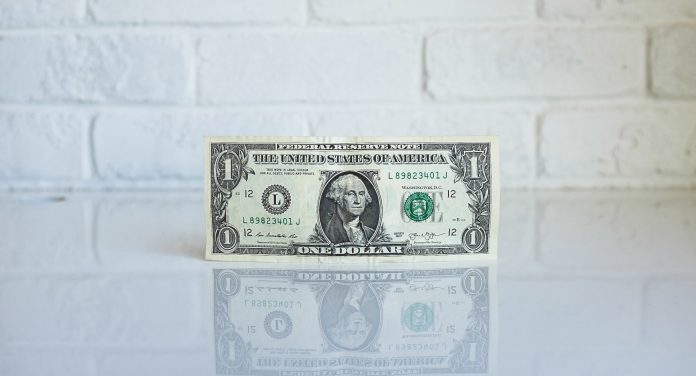A combination of dollar strength and pound weakness sent the pound US dollar exchange rate 0.4% lower on Monday. The pair tumbled to a 10 day low of US$1.2632. The pound is edging higher in early trade on Tuesday.
| What do these figures mean? |
|---|
|
When measuring the value of a pair of currencies, one set equals 1 unit and the other shows the current equivalent. As the market moves, the amount will vary from minute to minute. For example, it could be written: 1 GBP = 1.28934 USD Here, £1 is equivalent to approximately $1.29. This specifically measures the pound’s worth against the dollar. If the US dollar amount increases in this pairing, it’s positive for the pound. Or, if you were looking at it the other way around: 1 USD = 0.77786 GBP In this example, $1 is equivalent to approximately £0.78. This measures the US dollar’s worth versus the British pound. If the sterling number gets larger, it’s good news for the dollar. |
Weak UK manufacturing pmi data combined with No deal Brexit fears sent the pound lower in the previous session. The UK manufacturing pmi came in at 48, well below the 49.4 in May and below the 49.5 that analysts had predicted. The sector experienced its fastest contraction in six years as firms stopped stockpiling for a no deal Brexit and as domestic and international demand evaporated.
Economic growth in the first quarter was lacklustre but acceptable at 0.5%. With the manufacturing sector showing signs of having weakened significantly across the second quarter, economic growth could be impacted. The Bank of England Governor Mark Carney said he only expected growth of 0% in the second quarter.
| Why does poor economic data drag on a country’s currency? |
|---|
| Slowing economic indicators point to a slowing economy. Weak economies have weaker currencies because institutions look to reduce investments in countries where growth prospects are low and then transfer money to countries with higher growth prospects. These institutions sell out of their investment and the local currency, thus increasing supply of the currency and pushing down the money’s worth. So, when a country or region has poor economic news, the value of the currency tends to fall. |
Whilst the UK economic calendar was unnerving pound traders, so were comments from the Conservative leader candidates, particularly Jeremey Hunt. Up until now, Boris Johnson has been very clear that Brexit will happen on the 31st October, with or without a deal. Jeremy Hunt has, until now, kept his Brexit cards close to his chest. However, yesterday Jeremey Hunt also made it clear that Brexit without a deal was still very much a possibility should he take over as Prime Minister. Economists have frequently warned over the economic impact of a no deal Brexit. The pound dropped lower.
| Why is a “soft” Brexit better for sterling than a “hard” Brexit? |
|---|
| A soft Brexit implies anything less than UK’s complete withdrawal from the EU. For example, it could mean the UK retains some form of membership to the European Union single market in exchange for some free movement of people, i.e. immigration. This is considered more positive than a “hard” Brexit, which is a full severance from the EU. The reason “soft” is considered more pound-friendly is because the economic impact would be lower. If there is less negative impact on the economy, foreign investors will continue to invest in the UK. As investment requires local currency, this increased demand for the pound then boosts its value. |
Today UK construction pmi could offer further insight s to the health of the UK economy.
Dollar Rallies On Reduced Rate Cut Expectations
The dollar soared higher in the previous session as investors pushed back the possibility of an interest rate rise by the Federal Reserve. The trade truce between President Trump and China’s President Xi Jinping has fuelled hope that a serious global downturn could be avoided should the two sides strike a deal. With talks set to resume between the two powers the chances of a deal have increased.
Investors are expecting the Fed to now hold off from hiking at the July meeting. Just a few days ago, the markets were assuming that the Fed would almost definitely hike interest rates.
Today, there is no high impacting US economic data. Instead investors will be watching the Federal Reserve officials Mester and Williams as they speak, for further clues on the next steps from the Fed.
This publication is provided for general information purposes only and is not intended to cover every aspect of the topics with which it deals. It is not intended to amount to advice on which you should rely. You must obtain professional or specialist advice before taking, or refraining from, any action on the basis of the content in this publication. The information in this publication does not constitute legal, tax or other professional advice from TransferWise Inc., Currency Live or its affiliates. Prior results do not guarantee a similar outcome. We make no representations, warranties or guarantees, whether express or implied, that the content in the publication is accurate, complete or up to date. Consult our risk warning page for more details.
This article was initially published on TransferWise.com from the same author. The content at Currency Live is the sole opinion of the authors and in no way reflects the views of TransferWise Inc.





